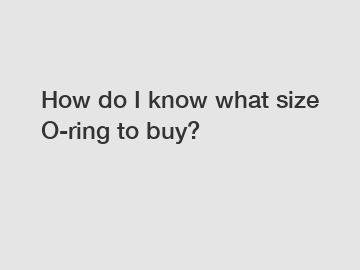How do I know what size O-ring to buy?
How do I know what size O-ring to buy?
When it comes to purchasing O-rings, it is essential to select the correct size to ensure a proper fit and a leak-free seal. O-rings are a commonly used sealing solution in various industries, including automotive, plumbing, and manufacturing. However, determining the right size can be a bit challenging for someone who is unfamiliar with O-ring sizing standards. This article will provide a guide on how to identify the correct size O-ring for your needs.
Understanding O-ring Sizing Standards.

O-rings are sized according to industry standards, which include both imperial and metric dimensions. The most commonly used sizing standard is the AS568 in the United States. This standard uses a three-digit dash number, which corresponds to specific dimensions. The first two digits represent the O-ring's inner diameter, and the last digit indicates the cross-sectional diameter (thickness).
Measuring the O-ring Size.
To measure an existing O-ring or determine the required size for a new application, you need to measure both the inner diameter and the cross-sectional diameter accurately. The inner diameter is the distance across the inside of the O-ring when it is in its natural circular shape. The cross-sectional diameter is the thickness or width of the O-ring when it is not under any compression.
Using a digital caliper, measure the inner diameter by placing the tips on opposite sides of the inside of the O-ring. Ensure the caliper is perpendicular to the axis of the O-ring for an accurate reading. Record the measurement in either inches or millimeters, depending on the unit of measurement used for O-rings in your region.
Next, measure the cross-sectional diameter by placing the caliper tips on opposite sides of the O-ring's cross-section. Again, make sure the caliper is perpendicular to the axis of the O-ring. Record this measurement as well.
Referring to the O-ring Size Chart.
Once you have the measurements, you can refer to an O-ring size chart to find the corresponding size. These charts provide a list of O-ring sizes, usually sorted in ascending order of inner diameter. Locate the inner diameter measurement on the chart and find the corresponding cross-sectional diameter. The combination of these two dimensions will indicate the correct O-ring size to purchase.
If you cannot find an exact match, it is generally recommended to choose the closest size available. O-rings can often accommodate slight variations in size due to their elastic properties. However, keep in mind that picking a significantly smaller or larger size than required might lead to an improper seal, leading to leaks or other issues.
Contact Us.
If you are still unsure about what size O-ring to purchase or have any further questions, do not hesitate to contact us. Our experienced staff will gladly assist you in finding the right O-ring size for your specific application. We understand the importance of selecting the correct size for a leak-free seal, and we are here to help you make the right choice.
In conclusion, selecting the correct size O-ring is crucial for ensuring a proper seal and preventing leaks. Familiarizing yourself with O-ring sizing standards, measuring accurately, and referring to O-ring size charts are essential steps in the process. If you have any uncertainties, our knowledgeable team is always available to provide assistance and guidance. Contact us today to find the perfect O-ring for your needs.
If you want to learn more, please visit our website Hydraulic Cylinder Piston Seal, wholesale oil seal products, difference between gasket and o ring.
136
0
0


Comments
All Comments (0)